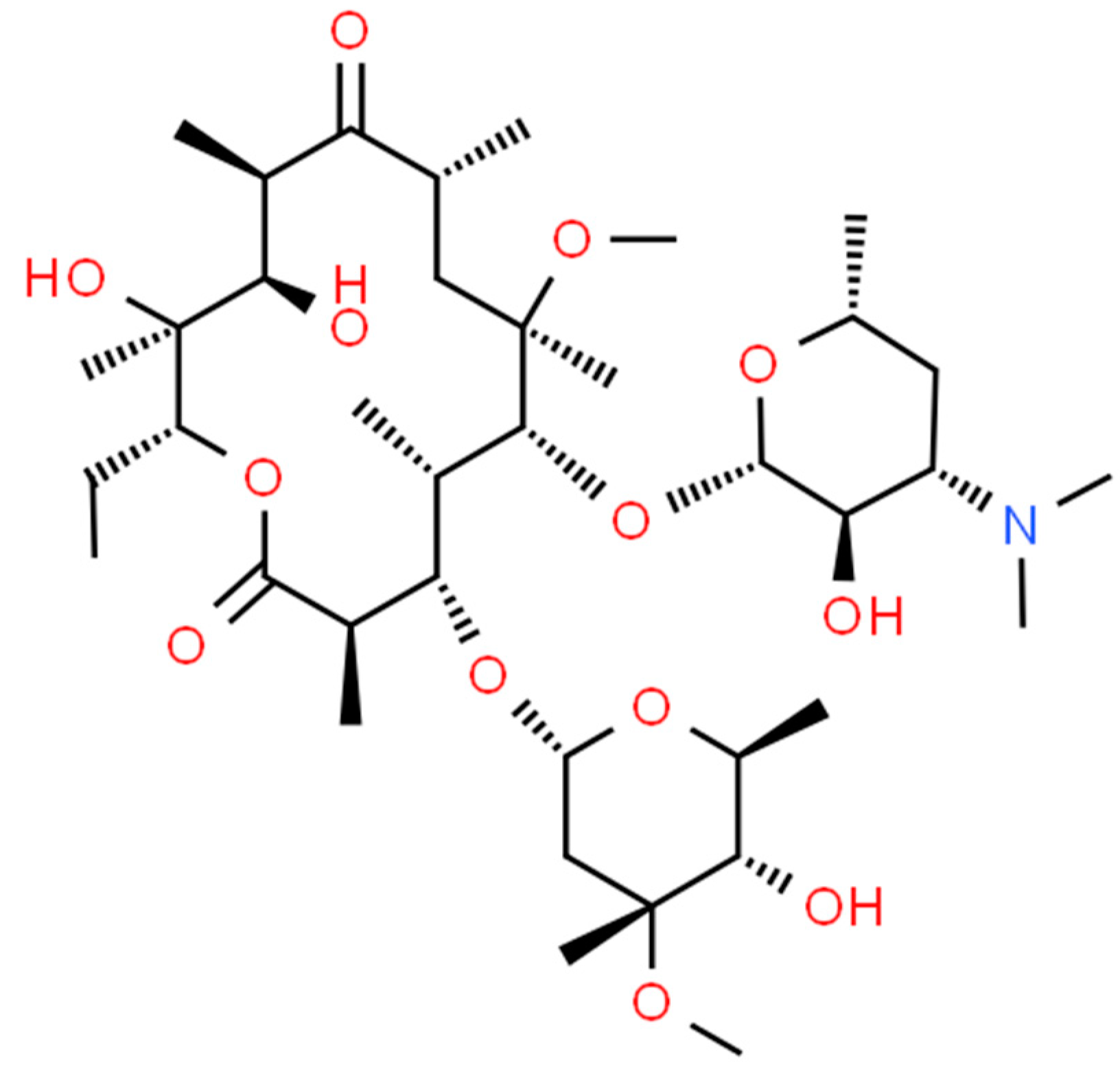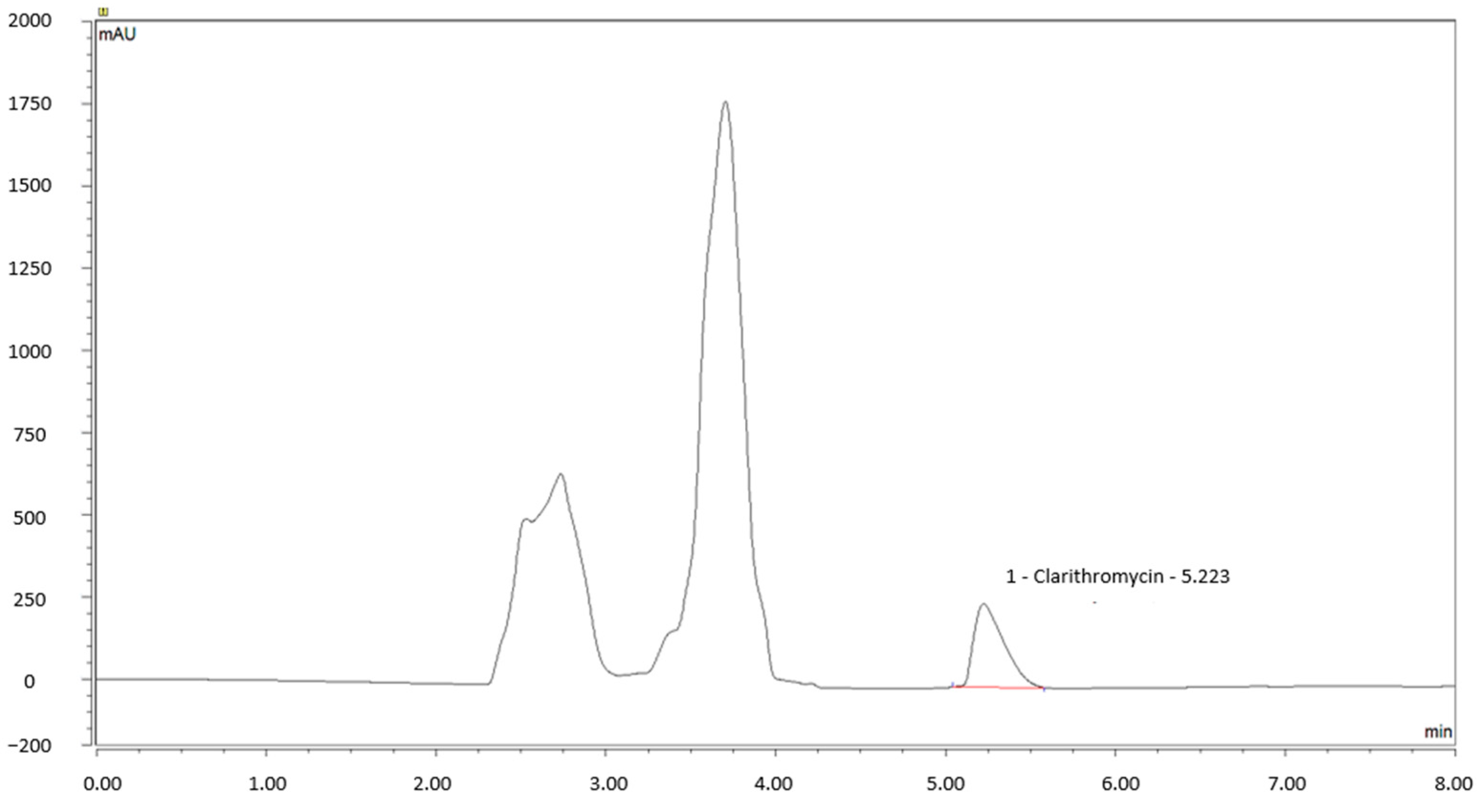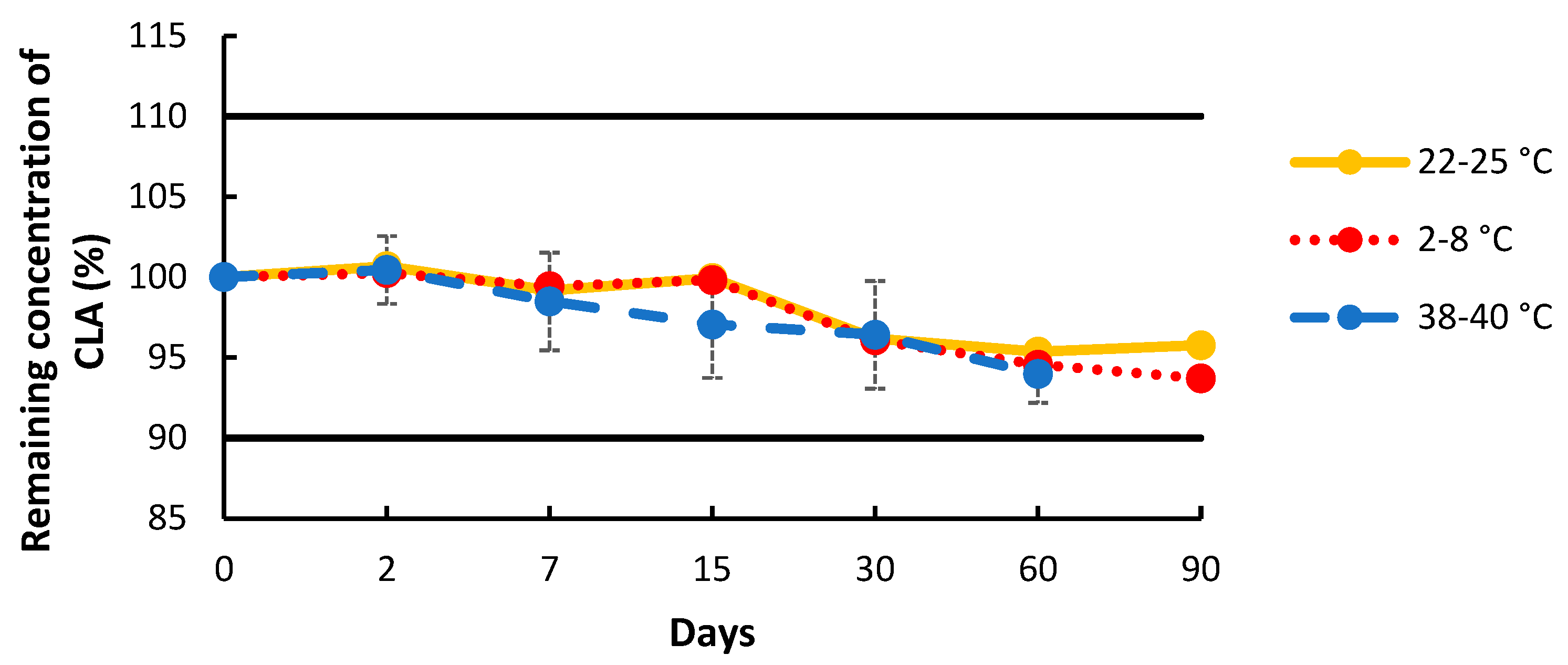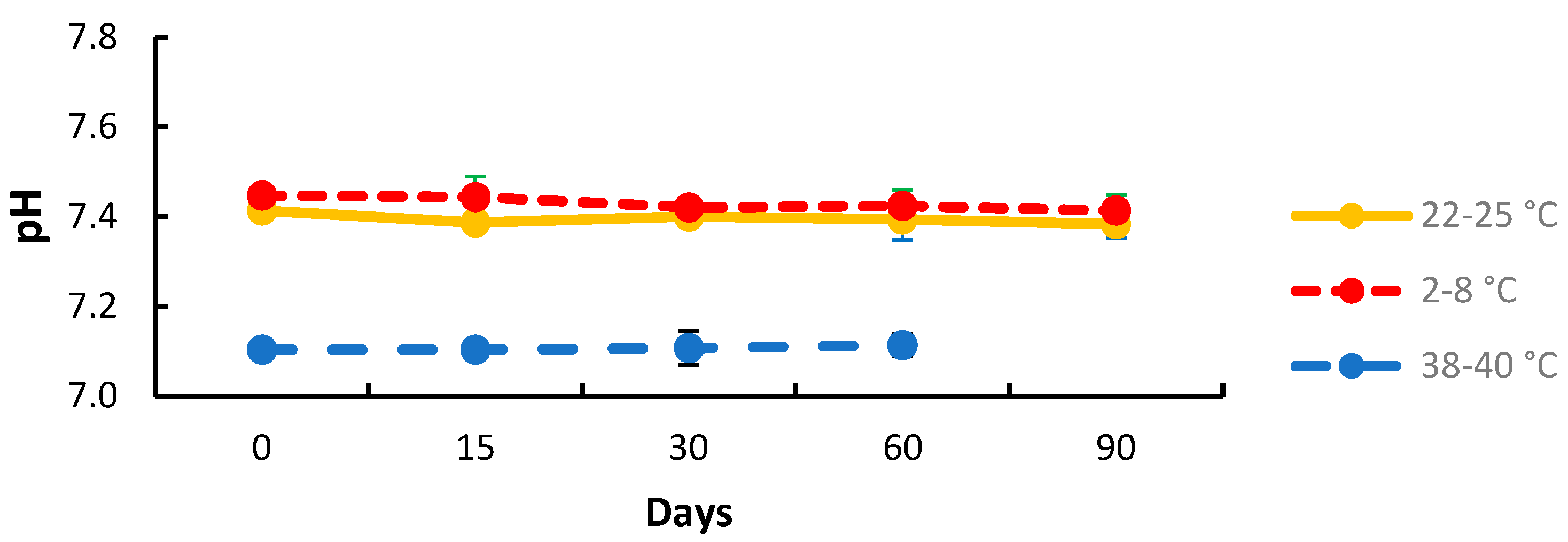Formulation and Stability of a 1% Clarithromycin-Based Topical Skin Cream: A New Option to Treat Buruli Ulcers?
Abstract
:1. Introduction
2. Results
2.1. Validation of the Stability-Indicating HPLC Method
2.2. Physico-Chemical Stability Study
3. Discussion
4. Materials and Methods
4.1. Chemical and Reagents
4.2. CLA Cream Formulation
4.3. Validation of the Stability-Indicating Liquid Chromatography Assay
4.3.1. Chromatographic Conditions
4.3.2. Validation of the HPLC Method
4.3.3. Sample Preparation
4.4. Chemical Stability of the Topical Formulation
4.5. Physical Stability
4.6. Statistical Analysis
5. Conclusions
Author Contributions
Funding
Institutional Review Board Statement
Informed Consent Statement
Data Availability Statement
Conflicts of Interest
References
- Franco-Paredes, C.; Marcos, L.A.; Henao-Martínez, A.F.; Rodríguez-Morales, A.J.; Villamil-Gómez, W.E.; Gotuzzo, E.; Bonifaz, A. Cutaneous Mycobacterial Infections. Clin. Microbiol. Rev. 2018, 32, e00069-18. [Google Scholar] [CrossRef] [PubMed]
- Gardini, G.; Gregori, N.; Matteelli, A.; Castelli, F. Mycobacterial Skin Infection. Curr. Opin. Infect. Dis. 2022, 35, 79–87. [Google Scholar] [CrossRef] [PubMed]
- Guarner, J. Buruli Ulcer: Review of a Neglected Skin Mycobacterial Disease. J. Clin. Microbiol. 2018, 56, e01507-17. [Google Scholar] [CrossRef] [PubMed]
- Brown-Elliott, B.A.; Woods, G.L. Antimycobacterial Susceptibility Testing of Nontuberculous Mycobacteria. J. Clin. Microbiol. 2019, 57, e00834-19. [Google Scholar] [CrossRef] [PubMed]
- Popa, G.L.; Muntean, A.A.; Popa, M.I. Recent Advances in the Management Strategies for Buruli Ulcers. Pathogens 2023, 12, 1088. [Google Scholar] [CrossRef]
- Aboagye, S.Y.; Kpeli, G.; Tuffour, J.; Yeboah-Manu, D. Challenges associated with the treatment of Buruli ulcer. J. Leukoc. Biol. févr 2019, 105, 233–242. [Google Scholar] [CrossRef] [PubMed]
- Chung, J.; Ince, D.; Ford, B.A.; Wanat, K.A. Cutaneous Infections Due to Nontuberculosis Mycobacterium: Recognition and Management. Am. J. Clin. Dermatol. 2018, 19, 867–878. [Google Scholar] [CrossRef]
- Barone, A.A.L.; Grzelak, M.J.; Frost, C.; Ngaage, L.M.; Ge, S.; Kolegraff, K.; Chopra, K.; Tornheim, J.A.; Caffrey, J.; Lifchez, S.D.; et al. Atypical Mycobacterial Infections After Plastic Surgery Procedures Abroad: A Multidisciplinary Algorithm for Diagnosis and Treatment. Ann. Plast. Surg. 2020, 84, 257–262. [Google Scholar] [CrossRef] [PubMed]
- Manani, R.O.; Abuga, K.O.; Chepkwony, H.K. Pharmaceutical Equivalence of Clarithromycin Oral Dosage Forms Marketed in Nairobi County, Kenya. Sci. Pharm. 2017, 85, 20. [Google Scholar] [CrossRef] [PubMed]
- Sturgill, M.G.; Rapp, R.P. Clarithromycin: Review of a new macrolide antibiotic with improved microbiologic spectrum and favorable pharmacokinetic and adverse effect profiles. Ann. Pharmacother. 1992, 26, 1099–1108. [Google Scholar] [CrossRef] [PubMed]
- Champney, W.S.; Burdine, R. Azithromycin and clarithromycin inhibition of 50S ribosomal subunit formation in Staphylococcus aureus cells. Curr. Microbiol. 1998, 36, 119–123. [Google Scholar] [CrossRef] [PubMed]
- Hardy, D.J. Extent and spectrum of the antimicrobial activity of clarithromycin. Pediatr. Infect. Dis. J. 1993, 12 (Suppl. S3), S99–S105. [Google Scholar] [CrossRef] [PubMed]
- Konan, D.O.; Mosi, L.; Fokou, G.; Dassi, C.; Narh, C.A.; Quaye, C.; Saric, J.; Abe, N.N.; Bonfoh, B. Buruli ulcer in southern Côte D’ivoire: Dynamic schemes of perception and interpretation of modes of transmission. J. Biosoc. Sci. 2019, 51, 520–533. [Google Scholar] [CrossRef] [PubMed]
- Prochazka, M.; Timothy, J.; Pullan, R.; Kollie, K.; Rogers, E.; Wright, A.; Palmer, J. «Buruli ulcer and leprosy, they are intertwined»: Patient experiences of integrated case management of skin neglected tropical diseases in Liberia. PLoS Negl. Trop. Dis. 2020, 14, e0008030. [Google Scholar] [CrossRef] [PubMed]
- Medel-Plaza, M.; Esteban, J. Current treatment options for Mycobacterium marinum cutaneous infections. Expert Opin. Pharmacother. 2023, 24, 1113–1123. [Google Scholar] [CrossRef] [PubMed]
- Gonzalez-Santiago, T.M.; Drage, L.A. Nontuberculous Mycobacteria: Skin and Soft Tissue Infections. Dermatol. Clin. 2015, 33, 563–577. [Google Scholar] [CrossRef] [PubMed]
- Simoes, S.; Carvalheiro, M.; Gaspar, M.M. Lipid-Based Nanocarriers for Cutaneous Leishmaniais and Buruli Ulcer Management. Curr. Pharm. Des. 2016, 22, 6577–6586. [Google Scholar] [CrossRef] [PubMed]
- Van Zyl, L.; du Plessis, J.; Viljoen, J. Cutaneous tuberculosis overview and current treatment regimens. Tuberc. Edinb. Scotl. 2015, 95, 629–638. [Google Scholar] [CrossRef] [PubMed]
- Francis, N.A.; Ridd, M.J.; Thomas-Jones, E.; Butler, C.C.; Hood, K.; Shepherd, V.; Marwick, C.A.; Huang, C.; Longo, M.; Wootton, M.; et al. Oral and Topical Antibiotics for Clinically Infected Eczema in Children: A Pragmatic Randomized Controlled Trial in Ambulatory Care. Ann. Fam. Med. 2017, 15, 124–130. [Google Scholar] [CrossRef] [PubMed]
- Nair, A.B.; Shah, J.; Al-Dhubiab, B.E.; Jacob, S.; Patel, S.S.; Venugopala, K.N.; Morsy, M.A.; Gupta, S.; Attimarad, M.; Sreeharsha, N.; et al. Clarithromycin Solid Lipid Nanoparticles for Topical Ocular Therapy: Optimization, Evaluation and In Vivo Studies. Pharmaceutics 2021, 13, 523. [Google Scholar] [CrossRef] [PubMed]
- Philips, R.C.; Hoyer, P.E.; White, S.M.; Tinkey, K.T.; Loeffelholz, M.; Andersen, C.R.; Wilkerson, M.G.; Gibson, B.R.; Kelly, B.C. Cutaneous nontuberculous mycobacteria infections: A retrospective case series of 78 patients from the Texas Gulf Coast region. J. Am. Acad. Dermatol. 2019, 81, 730–739. [Google Scholar] [CrossRef] [PubMed]
- Dodiuk-Gad, R.; Dyachenko, P.; Ziv, M.; Shani-Adir, A.; Oren, Y.; Mendelovici, S.; Shafer, J.; Chazan, B.; Raz, R.; Keness, Y.; et al. Nontuberculous mycobacterial infections of the skin: A retrospective study of 25 cases. J. Am. Acad. Dermatol. 2007, 57, 413–420. [Google Scholar] [CrossRef] [PubMed]
- Van der Paardt, A.F.L.; Akkerman, O.W.; Gualano, G.; Palmieri, F.; Forsman, L.D.; Aleksa, A.; Tiberi, S.; de Lange, W.C.; Bolhuis, M.S.; Skrahina, A.; et al. Safety and tolerability of clarithromycin in the treatment of multidrug-resistant tuberculosis. Eur. Respir. J. 2017, 49, 1601612. [Google Scholar] [CrossRef] [PubMed]
- Phillips, R.O.; Robert, J.; Abass, K.M.; Thompson, W.; Sarfo, F.S.; Wilson, T.; Sarpong, G.; Gateau, T.; Chauty, A.; Omollo, R.; et al. Rifampicin and Clarithromycin (Extended Release) Versus Rifampicin and Streptomycin for Limited Buruli Ulcer Lesions: A Randomised, Open-Label, Non-Inferiority Phase 3 Trial. Lancet 2020, 395, 1259–1267. [Google Scholar] [CrossRef] [PubMed]
- Cowling, T.; Jones, S. Topical Antibiotics for Infected Wounds: A Review of the Clinical Effectiveness and Guidelines; CADTH Rapid Response Reports; Canadian Agency for Drugs and Technologies in Health: Ottawa, ON, Canada, 2017. Available online: http://www.ncbi.nlm.nih.gov/books/NBK487400/ (accessed on 14 February 2024).
- Van Haarst, A.D.; van’t Klooster, G.A.; van Gerven, J.M.; Schoemaker, R.C.; van Oene, J.C.; Burggraaf, J.; Coene, M.C.; Cohen, A.F. The influence of cisapride and clarithromycin on QT intervals in healthy volunteers. Clin. Pharmacol. Ther. 1998, 64, 542–546. [Google Scholar] [CrossRef] [PubMed]
- Brown, B.A.; Wallace, R.J.; Griffith, D.E.; Girard, W. Clarithromycin-induced hepatotoxicity. Clin. Infect. Dis. 1995, 20, 1073–1074. [Google Scholar] [CrossRef] [PubMed]
- Portaels, F.; Traore, H.; De Ridder, K.; Meyers, W.M. In vitro susceptibility of Mycobacterium ulcerans to clarithromycin. Antimicrob. Agents Chemother. 1998, 42, 2070–2073. [Google Scholar] [CrossRef] [PubMed]
- Bourdon, F.; Lecoeur, M.; Leconte, L.; Ultré, V.; Kouach, M.; Odou, P.; Vaccher, C.; Foulon, C. Evaluation of Pentravan®, Pentravan® Plus, Phytobase®, Lipovan® and Pluronic Lecithin Organogel for the Transdermal Administration of Antiemetic Drugs to Treat Chemotherapy-Induced Nausea and Vomiting at the Hospital. Int. J. Pharm. 2016, 515, 774–787. [Google Scholar] [CrossRef] [PubMed]
- Polonini, H.C.; Brandão, M.A.F.; Ferreira, A.O.; Ramos, C.; Raposo, N.R.B. Evaluation of percutaneous absorption performance for human female sexual steroids into pentravan cream. Int. J. Pharm. Compd. 2014, 18, 332–340. [Google Scholar]
- Polonini, H.; Taylor, S.; Zander, C. Compatibility of Different Formulations in Pentravan® and Pentravan® Plus for Transdermal Drug Delivery. Sci. Pharm. 2021, 89, 51. [Google Scholar] [CrossRef]
- Sutar, R.; Masareddy, R. Formulation and evaluation of clarithromycin poorly soluble drug as microemulsion. Int. Res. J. Pharm. 2011, 2, 153–158. [Google Scholar]
- Osborne, D.W.; Musakhanian, J. Skin Penetration and Permeation Properties of Transcutol®-Neat or Diluted Mixtures. AAPS PharmSciTech. 2018, 19, 3512–3533. [Google Scholar] [CrossRef] [PubMed]
- Javadzadeh, Y.; Shokri, J.; Hallaj-Nezhadi, S.; Hamishehkar, H.; Nokhodchi, A. Enhancement of percutaneous absorption of finasteride by cosolvents, cosurfactant and surfactants. Pharm. Dev. Technol. 2010, 15, 619–625. [Google Scholar] [CrossRef] [PubMed]
- Caserta, F.; Brown, M.B.; McAuley, W.J. The Use of Heat and Chemical Penetration Enhancers to Increase the Follicular Delivery of Erythromycin to the Skin. Eur. J. Pharm. Sci. 2019, 132, 55–62. [Google Scholar] [CrossRef] [PubMed]
- European Pharmacopoeiaa. Clarithromycin. Monograph 04/2018:1651. European Pharmacopoeia Ed. 10.5. Available online: https://pheur.edqm.eu/app/11-5/content/11-5/1651E.htm?highlight=on&terms=clarithromycin (accessed on 15 January 2020).
- Pereira, J.M.; Mejia-Ariza, R.; Ilevbare, G.A.; McGettigan, H.E.; Sriranganathan, N.; Taylor, L.S.; Davis, R.M.; Edgar, K.J. Interplay of degradation, dissolution and stabilization of clarithromycin and its amorphous solid dispersions. Mol. Pharm. 2013, 10, 4640–4653. [Google Scholar] [CrossRef] [PubMed]
- Fujiki, S.; Iwao, Y.; Kobayashi, M.; Miyagishima, A.; Itai, S. Stabilization mechanism of clarithromycin tablets under gastric pH conditions. Chem. Pharm. Bull 2011, 59, 553–558. [Google Scholar] [CrossRef] [PubMed]
- WEPA Apothekenbedarf. Topitec® Touch, WEPA Apothekenbedarf GmbH & Co KG, ID 701815. Available online: https://www.topitec.de/sortiment/mischsysteme/topitec-touch/ (accessed on 14 February 2024).
- European Medicines Agency. ICH Topic Q1A(R2): Stability Testing of New Drug Substances and Products. Available online: https://www.ema.europa.eu/en/documents/scientific-guideline/ich-q-1-r2-stability-testing-new-drug-substances-products-step-5_en.pdf (accessed on 3 February 2020).
- Morgan, D.K.; Brown, D.M.; Rotsch, T.D.; Plasz, A.C. A reversed-phase high-performance liquid chromatographic method for the determination and identification of clarithromycin as the drug substance and in various dosage forms. J. Pharm. Biomed. Anal. 1991, 9, 261–269. [Google Scholar] [CrossRef] [PubMed]
- Park, J.B.; Park, Y.J.; Kang, C.Y.; Lee, B.J. Modulation of microenvironmental pH and utilization of alkalizers in crystalline solid dispersion for enhanced solubility and stability of clarithromicin. Arch. Pharm. Res. 2015, 38, 839–848. [Google Scholar] [CrossRef] [PubMed]
- Abuga, K.O.; Chepkwony, H.K.; Roets, E.; Hoogmartens, J. A Stability-Indicating HPLC Method for the Separation of Clarithromycin and Related Substances in Bulk Samples. J. Sep. Sci. 2001, 24, 849–855. [Google Scholar] [CrossRef]
- International Conference on Harmonisation of Technical Requirements for Registration of Pharmaceuticals for Human Use. Validation of Analytical Procedures: Text and Methodology Q2(R1). Available online: https://database.ich.org/sites/default/files/Q2_R1__Guideline.pdf (accessed on 3 February 2020).
- Food Drug and Administration. Guidance for Industry: Drug Stability Guidelines. Available online: https://www.fda.gov/media/69957/download (accessed on 3 February 2020).




| Theoretical Concentration (mg/mL) | Mean Peak Area (mAU.min) ± SD (n = 3) | Calculated Concentration (mg/mL) |
|---|---|---|
| 0.8 | 24.35 ± 0.08 | 0.79 ± 0.03 |
| 0.9 | 28.19 ± 0.03 | 0.90 ± 0.01 |
| 1.0 | 31.60 ± 0.11 | 0.99 ± 0.04 |
| 1.1 | 35.49 ± 0.15 | 1.10 ± 0.05 |
| 1.2 | 38.35 ± 0.08 | 1.19 ± 0.03 |
| Concentration (mg/mL) | Intraday Precision | Interday Precision | ||
|---|---|---|---|---|
| Mean Peak Area ± SD (n = 3) | RSD (%) | Mean Peak Area ± SD (n = 6) | RSD (%) | |
| 0.85 | 25.5 ± 0.1 | 0.2 | 25.5 ± 0.1 | 0.3 |
| 1.0 | 30.4 ± 0.1 | 0.2 | 30.6 ± 0.1 | 0.2 |
| 1.15 | 35.5 ± 0.1 | 0.3 | 35.3 ± 0.1 | 0.3 |
| Theoretical Concentration (mg/mL) | Calculated Concentration (mg/mL) | Recovery (%) | RSD (%) |
|---|---|---|---|
| 0.80 | 0.81 ± 0.03 | 101.5 ± 0.3 | 0.3 |
| 0.90 | 0.90 ± 0.05 | 100.3 ± 0.9 | 0.9 |
| 1.0 | 1.01 ± 0.03 | 100.8 ± 0.3 | 0.3 |
| 1.10 | 1.10 ± 0.03 | 100.3 ± 0.3 | 0.3 |
| 1.20 | 1.21 ± 0.04 | 100.8 ± 0.3 | 0.3 |
| Extraction Solvent | Times (h) | Recovery (%) |
|---|---|---|
| Acetone | 1 | 41 |
| 3 | 46 | |
| Acetonitrile | 1 | 77 |
| Methanol | 1 | 69 |
| 3 | 80 |
| Stress Condition | % CLA Remaining | Retention Time of Degradation Product (min) | ||
|---|---|---|---|---|
| H0 | H1 | H48 | ||
| Acidic stress (HCl 5 M, 60 °C, 48 h) | 51 | 0 | 0 | 2.7–4.4 |
| Alkaline stress (NaOH 5 M, 60 °C, 48 h) | 97 | 97 | 97 | 2.9 |
| Oxidative stress (3%, H2O2, 60 °C, 48 h) | 92 | 14 | 0 | 2.8–4.0–4.7–6.0 |
| Ingredients | Amount for 100 g |
|---|---|
| Clarithromycin lactobionate | 1.49 g (equivalent to 1 g of clarithromycin base) |
| Transcutol® | 10 g |
| Ascorbic acid | 0.1 g |
| Pentravan® | Adjust to 100 g |
| Sodium hydroxide | pH adjusted to 7.3 ± 0.2 |
Disclaimer/Publisher’s Note: The statements, opinions and data contained in all publications are solely those of the individual author(s) and contributor(s) and not of MDPI and/or the editor(s). MDPI and/or the editor(s) disclaim responsibility for any injury to people or property resulting from any ideas, methods, instructions or products referred to in the content. |
© 2024 by the authors. Licensee MDPI, Basel, Switzerland. This article is an open access article distributed under the terms and conditions of the Creative Commons Attribution (CC BY) license (https://creativecommons.org/licenses/by/4.0/).
Share and Cite
Sebti, M.; Schweitzer-Chaput, A.; Cisternino, S.; Hinterlang, M.; Ancedy, D.; Lam, S.; Auvity, S.; Cotteret, C.; Lortholary, O.; Schlatter, J. Formulation and Stability of a 1% Clarithromycin-Based Topical Skin Cream: A New Option to Treat Buruli Ulcers? Pharmaceuticals 2024, 17, 691. https://doi.org/10.3390/ph17060691
Sebti M, Schweitzer-Chaput A, Cisternino S, Hinterlang M, Ancedy D, Lam S, Auvity S, Cotteret C, Lortholary O, Schlatter J. Formulation and Stability of a 1% Clarithromycin-Based Topical Skin Cream: A New Option to Treat Buruli Ulcers? Pharmaceuticals. 2024; 17(6):691. https://doi.org/10.3390/ph17060691
Chicago/Turabian StyleSebti, Maria, Arnaud Schweitzer-Chaput, Salvatore Cisternino, Mélanie Hinterlang, Dimitri Ancedy, Sandrine Lam, Sylvain Auvity, Camille Cotteret, Olivier Lortholary, and Joël Schlatter. 2024. "Formulation and Stability of a 1% Clarithromycin-Based Topical Skin Cream: A New Option to Treat Buruli Ulcers?" Pharmaceuticals 17, no. 6: 691. https://doi.org/10.3390/ph17060691







